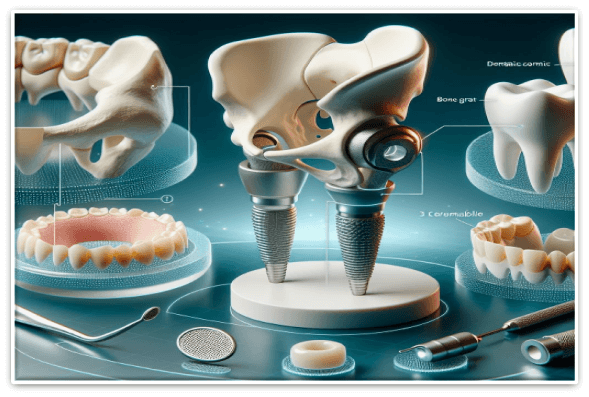Innovating Healthcare: How Medical Ceramics Are Reshaping Treatment
Published Date: 20 Sep 2024
Medical ceramics are rapidly becoming an important part of the modern healthcare system, with their array of unmatched properties that confer many advantages. Medical ceramics, or bioceramics are advanced materials formed from inorganic, non-metallic compounds, like zirconia, alumina, silica, and hydroxyapatite that are suitable for use in the human body. These undergo a wide range of medical applications, from joint replacement to dental implants.

Why are doctors using them?
Prosthetics are artificial body parts used to replace ones that are missing or have been lost due to injury, disease, or birth defects. For example, a prosthetic leg or arm helps someone move and function after losing a limb. Earlier prosthetics were not as comfortable and strong as human bones and tissue, but with the innovations that come from medical ceramics, prosthetics can now be made from ceramic material. Since they contain excellent biocompatibility and both sharp durability and versatility, it is transforming how treatments are delivered, making surgeries more successful, prosthetics more reliable, and healing faster.
Are they safe?
The key properties that make medical ceramics a safer choice in today's world include their Sterile nature, Durability, Resistance to chemicals (API), Extremely high compressive strength, Low friction coefficient, and exceptional aesthetics of the finished product.
Medical ceramics are utilized in various areas of the healthcare sector, however, there are some major areas where they are highly used and innovative healthcare:
- Orthopedic Implants: A New Era
Traditionally, joint replacements, hip and knee implants, could be met using metal alloys. Most of the implants designed by previous manufacturers were the problem-prone metal-on-metal type, with disadvantages such as wear and tear, thereby causing discomfort, inflammation, and some necessitating revision surgery.
Medical ceramics, particularly zirconia, can be used as a potential alternative. Zirconia implants are extremely biocompatible. Consequently, fewer risks related to allergic reactions and tissue rejection occur. Additionally, the material does not degrade easily, contributing to more durable implants, less short-term pain, and better patient outcomes due to reduced revisions. - Dental Restorations: Beyond Aesthetics
Medical ceramics have also been applied in the dental field where they are used to make implants and crowns much steadier and more durable than those fabricated from metal. This has greatly improved the quality of life for many people suffering from dental problems. For example, the latest ceramic material, lithium disilicate, holds improved strength and translucency for full-contour restorations. Besides aesthetics, those restorations hold great durability and biocompatibility as well. - Cardiovascular Devices: Innovations on Heartbeats
Medical ceramics are also still generating considerable advances in cardiovascular medicine.- Ceramic stents have several advantages over ordinary metal stents that are commonly used for the treatment of coronary artery disease prevent more chances of thrombosis and facilitate the growth of new blood vessels that result in a better supply of blood to the heart.
- Medical ceramics have been used to design implantable medical devices, for instance, pacemakers. They are designed to be light in weight and extremely durable, which makes them very suitable for long-term use. Therefore, these will continue in further development with improvements in technology.
- Bone Regeneration: Future Medicine
Bioactive ceramic scaffolds can be designed to end with a structure close to that of the natural bone, therefore creating a proper environment where bone cells can grow and begin to regenerate. Such scaffolds are quite useful in repairing bone defects resulting from trauma, infection, or congenital conditions. In addition, this may mark the beginning of life-saving implants and artificial organs based on medical ceramics.
Overcoming Challenges and Seizing Opportunities
Major opportunities exist in medical bioceramics, with several challenges, however, that need to be overcome through action likely to ensure sustained growth.
- One major limitation exists in this area because production costs are relatively high, and thus a possible constraint on making bioceramic-based products more accessible to consumers, especially those in developing regions. More research and innovation efforts are likely to cut production costs over time and consequently extend access to these advanced materials.
- Another challenge is the necessity for rigorous testing and regulatory approval, with lengthy and expensive sequences, however, as the benefits of bioceramics grow, then regulatory bodies are increasingly supportive of the development and commercialization of these materials for broader application.
These challenges will make the medical bioceramics market continue to grow and prosper, thus contributing to betterment in health and surgery by offering novel solutions to some of the latest problems currently facing medicine.
Future innovations
The future is endless with vast possibilities. As the process of research and development moves ahead, applications of medical ceramics will expand even more. It may potentially include advances in drug delivery systems, tissue engineering, and other emerging medical fields. Medical ceramics present a rich and promising field for innovative health solutions, significantly improving patient outcomes and quality of life. Medical bioceramics are promising and have, therefore, expanded their application in cardiology, neurology, ophthalmology, and other medical fields. The demand for more specialized medical treatments will make the market for bioceramics expand.
Conclusion
Medical bioceramics can change the health scenario of this world by offering new options for treatment, recovery, and patient care. Their unique properties will see them form the very foundation of modern medical devices and implants, driving the advance in surgery and other healthcare matters. The role of medical bioceramics will be integral to defining future healthcare innovations and providing new solutions that improve the quality of life of patients as the business continues to grow and expand. In short, it can be said that medical ceramics are a breakthrough material in healthcare. Many more innovations in treatment would be expected with progress in research and development in years to come.
Maximize your value and knowledge with our 5 Reports-in-1 Bundle - over 40% off!
Our analysts are ready to help you immediately.
